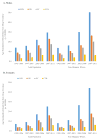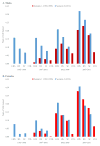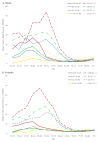The Contribution of Drug Overdose to Educational Gradients in Life Expectancy in the United States, 1992-2011 - PubMed (original) (raw)
The Contribution of Drug Overdose to Educational Gradients in Life Expectancy in the United States, 1992-2011
Jessica Y Ho. Demography. 2017 Jun.
Abstract
Since the mid-1990s, the United States has witnessed a dramatic rise in drug overdose mortality. Educational gradients in life expectancy widened over the same period, and drug overdose likely plays a role in this widening, particularly for non-Hispanic whites. The contemporary drug epidemic is distinctive in terms of its scope, the nature of the substances involved, and its geographic patterning, which influence how it impacts different education groups. I use vital statistics and National Health Interview Survey data to examine the contribution of drug overdose to educational gradients in life expectancy from 1992-2011. I find that over this period, years of life lost due to drug overdose increased for all education groups and for both males and females. The contribution of drug overdose to educational gradients in life expectancy has increased over time and is greater for non-Hispanic whites than for the population as a whole. Drug overdose accounts for a sizable proportion of the increases in educational gradients in life expectancy, particularly at the prime adult ages (ages 30-60), where it accounts for 25 % to 100 % of the widening in educational gradients between 1992 and 2011. Drug overdose mortality has increased more rapidly for females than for males, leading to a gender convergence. These findings shed light on the processes driving recent changes in educational gradients in life expectancy and suggest that effective measures to address the drug overdose epidemic should take into account its differential burden across education groups.
Keywords: Drug overdose; Educational gradients; Life expectancy.
Figures
Figure 1
Age-standardized death rates (p. 100,000) from drug overdose by education, 1992–2011 Note: Estimates are based on data from the CDC/NCHS Multiple Cause-of-Death files and the National Health Interview Survey (NHIS). LHS=Less than high school, HS=High school, SC=Some college, COL=College or more.
Figure 2
Years of life gained at ages 25+ by education, two counterfactual scenarios, 1992–2011 Note: Estimates are based on data from the CDC/NCHS Multiple Cause-of-Death files and the National Health Interview Survey (NHIS). LHS=Less than high school, HS=High school, SC=Some college, COL=College or more.
Appendix Figure 1
Age-specific death rates (p. 100,000) from drug overdose by education, 1992–1996 and 2007–2011 Note: Estimates are based on data from the CDC/NCHS Multiple Cause-of-Death files and the National Health Interview Survey (NHIS). LHS=Less than high school, HS=High school, SC=Some college, COL=College or more.
Similar articles
- Trends in U.S. life expectancy gradients: the role of changing educational composition.
Hendi AS. Hendi AS. Int J Epidemiol. 2015 Jun;44(3):946-55. doi: 10.1093/ije/dyv062. Epub 2015 May 4. Int J Epidemiol. 2015. PMID: 25939662 Free PMC article. - Trends in Education-Specific Life Expectancy, Data Quality, and Shifting Education Distributions: A Note on Recent Research.
Hendi AS. Hendi AS. Demography. 2017 Jun;54(3):1203-1213. doi: 10.1007/s13524-017-0574-2. Demography. 2017. PMID: 28397178 Free PMC article. - The Contribution of Smoking to Educational Gradients in U.S. Life Expectancy.
Ho JY, Fenelon A. Ho JY, et al. J Health Soc Behav. 2015 Sep;56(3):307-22. doi: 10.1177/0022146515592731. Epub 2015 Jul 21. J Health Soc Behav. 2015. PMID: 26199287 Free PMC article. - Trends in Life Expectancy and Lifespan Variation by Educational Attainment: United States, 1990-2010.
Sasson I. Sasson I. Demography. 2016 Apr;53(2):269-93. doi: 10.1007/s13524-015-0453-7. Demography. 2016. PMID: 26813781 Free PMC article. - The gap gets bigger: changes in mortality and life expectancy, by education, 1981-2000.
Meara ER, Richards S, Cutler DM. Meara ER, et al. Health Aff (Millwood). 2008 Mar-Apr;27(2):350-60. doi: 10.1377/hlthaff.27.2.350. Health Aff (Millwood). 2008. PMID: 18332489 Free PMC article.
Cited by
- Life expectancy and geographic variation in mortality: an observational comparison study of six high-income Anglophone countries.
Wilkie RZ, Ho JY. Wilkie RZ, et al. BMJ Open. 2024 Aug 13;14(7):e079365. doi: 10.1136/bmjopen-2023-079365. BMJ Open. 2024. PMID: 39138004 Free PMC article. - Women's Health: Population Patterns and Social Determinants.
Short SE, Zacher M. Short SE, et al. Annu Rev Sociol. 2022 Jul;48:277-298. doi: 10.1146/annurev-soc-030320-034200. Epub 2022 May 13. Annu Rev Sociol. 2022. PMID: 38765764 Free PMC article. - Urban-Rural Disparities in Deaths of Despair: A County-Level Analysis 2004-2016 in the U.S.
Lee JH, Wheeler DC, Zimmerman EB, Hines AL, Chapman DA. Lee JH, et al. Am J Prev Med. 2023 Feb;64(2):149-156. doi: 10.1016/j.amepre.2022.08.022. Epub 2022 Oct 28. Am J Prev Med. 2023. PMID: 38584644 Free PMC article. - U.S. Fertility in Life Course Context: A Research Note on Using Census-Held Linked Administrative Records for Geographic and Sociodemographic Subgroup Estimation.
Root L, Stevenson AJ, Genadek K, Yeatman S, Mollborn S, Menken J. Root L, et al. Demography. 2024 Apr 1;61(2):251-266. doi: 10.1215/00703370-11234861. Demography. 2024. PMID: 38506313 Free PMC article. - Reevaluating the "deaths of despair" narrative: Racial/ethnic heterogeneity in the trend of psychological distress-related death.
Zheng H, Choi Y. Zheng H, et al. Proc Natl Acad Sci U S A. 2024 Feb 20;121(8):e2307656121. doi: 10.1073/pnas.2307656121. Epub 2024 Feb 5. Proc Natl Acad Sci U S A. 2024. PMID: 38315821 Free PMC article.
References
- American Pain Society. Principles of Analgesic Use in the Treatment of Acute Pain and Cancer Pain. Vol. 4. Glenview, IL: American Pain Society; 1999.
- Bebinger M. FDA Considering Pricey Implant As Treatment For Opioid Addiction. National Public Radio. 2016 May 20; Retrieved from: http://www.npr.org/sections/health-shots/2016/05/20/478577515/fda-consid....
- Bohnert AS, Valenstein M, Bair MJ, Ganoczy D, McCarthy JF, Ilgen MA, Blow FC. Association between opioid prescribing patterns and opioid overdose-related deaths. Journal of the American Medical Association. 2011;305:1315–1321. - PubMed
MeSH terms
LinkOut - more resources
Full Text Sources
Other Literature Sources


